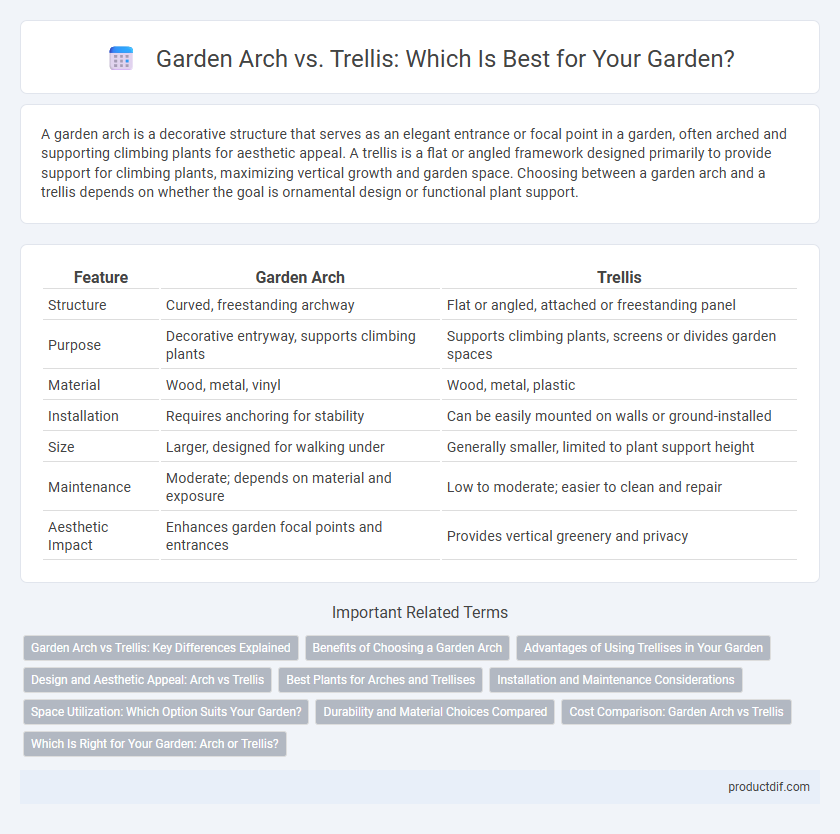A garden arch is a decorative structure that serves as an elegant entrance or focal point in a garden, often arched and supporting climbing plants for aesthetic appeal. A trellis is a flat or angled framework designed primarily to provide support for climbing plants, maximizing vertical growth and garden space. Choosing between a garden arch and a trellis depends on whether the goal is ornamental design or functional plant support.
Table of Comparison
| Feature | Garden Arch | Trellis |
|---|---|---|
| Structure | Curved, freestanding archway | Flat or angled, attached or freestanding panel |
| Purpose | Decorative entryway, supports climbing plants | Supports climbing plants, screens or divides garden spaces |
| Material | Wood, metal, vinyl | Wood, metal, plastic |
| Installation | Requires anchoring for stability | Can be easily mounted on walls or ground-installed |
| Size | Larger, designed for walking under | Generally smaller, limited to plant support height |
| Maintenance | Moderate; depends on material and exposure | Low to moderate; easier to clean and repair |
| Aesthetic Impact | Enhances garden focal points and entrances | Provides vertical greenery and privacy |
Garden Arch vs Trellis: Key Differences Explained
Garden arches and trellises serve distinct functions in garden design; garden arches primarily provide structural entrances or focal points often used for climbing plants, while trellises are typically flat frameworks supporting plant growth against walls or as standalone partitions. Garden arches are usually larger and more decorative, creating vertical interest and pathways, whereas trellises optimize space for vine cultivation by maximizing vertical planting surfaces. Material choice and design variations also differ, with arches often made of metal or wood for durability and aesthetics, and trellises designed for practical support and easy installation.
Benefits of Choosing a Garden Arch
A garden arch creates a stunning vertical focal point that enhances outdoor aesthetics while providing structural support for climbing plants like roses and clematis. Its sturdy framework increases garden accessibility by forming inviting entryways and defines spaces within the garden for better organization. Garden arches also promote healthy plant growth by improving air circulation and exposure to sunlight, leading to more vibrant blooms and higher yields.
Advantages of Using Trellises in Your Garden
Trellises offer significant space-saving advantages by encouraging vertical plant growth, ideal for small or urban gardens. They improve air circulation around plants, reducing the risk of fungal diseases and promoting healthier growth. Additionally, trellises provide versatile support for a wide range of climbing plants, enhancing garden aesthetics while maximizing planting efficiency.
Design and Aesthetic Appeal: Arch vs Trellis
Garden arches create a dramatic, curved focal point that enhances vertical interest and guides visitors through outdoor spaces, adding elegance and charm. Trellises offer a more structured, flat or latticed design ideal for supporting climbing plants and defining garden boundaries, contributing to a neat and organized aesthetic. Choosing between an arch and a trellis depends on the desired visual impact and functional role within the garden's overall design scheme.
Best Plants for Arches and Trellises
Garden arches and trellises provide vertical support ideal for climbing plants such as clematis, wisteria, and climbing roses, which thrive on arches' curved structures. Trellises are perfect for espaliered fruit trees, vines like grape and kiwi, and vigorous climbers including jasmine and honeysuckle, benefiting from their flat, supportive framework. Choosing the right plants depends on sunlight exposure and growth habits, ensuring optimal coverage and aesthetic appeal for both garden arches and trellises.
Installation and Maintenance Considerations
Garden arches typically require secure anchoring in the soil using stakes or concrete bases to ensure stability, while trellises can be mounted against walls or fences with brackets for easier installation. Maintenance for garden arches involves regular inspection for rust or wood rot, depending on the material, and tightening bolts or screws to maintain structural integrity. Trellises generally need less upkeep but should be checked for loose hardware and cleaned periodically to prevent mold and mildew buildup.
Space Utilization: Which Option Suits Your Garden?
A garden arch efficiently maximizes vertical space, allowing climbing plants to grow upward and creating an inviting entryway or focal point in small gardens. In contrast, a trellis offers flexible placement options against walls or as standalone screens, making it ideal for optimizing horizontal space and supporting a broader range of plants. Choosing between an arch and trellis depends on your garden's layout and the specific spatial requirements for plant growth and aesthetic design.
Durability and Material Choices Compared
Garden arches are typically crafted from sturdy materials like steel, wrought iron, or weather-resistant wood, providing superior durability for supporting heavy climbing plants over time. Trellises often come in lighter materials such as wood, bamboo, or vinyl, which may offer less strength but greater flexibility and easier installation. Metal garden arches generally outperform wooden trellises in longevity and resistance to outdoor elements, making them ideal for long-term garden structures.
Cost Comparison: Garden Arch vs Trellis
Garden arches generally cost more than trellises due to their larger size and more intricate design, with prices ranging from $100 to $500 depending on materials like wrought iron or cedar wood. Trellises, being smaller and simpler, typically range from $30 to $150, making them a more budget-friendly option for supporting climbing plants or dividing garden areas. Choosing between a garden arch and a trellis depends on budget constraints and the desired aesthetic impact in the garden space.
Which Is Right for Your Garden: Arch or Trellis?
A garden arch provides an elegant, vertical focal point ideal for climbing roses or vines, creating a picturesque entryway or pathway. Trellises offer versatile support for a variety of plants, maximising vertical space while aiding air circulation and sun exposure for healthier growth. Choosing between an arch and trellis depends on available space, plant types, and the desired aesthetic effect in your garden design.
Garden arch vs Trellis Infographic

 productdif.com
productdif.com